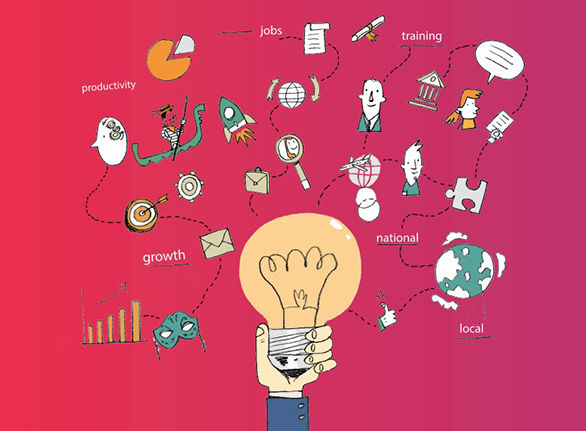OECD Observer Roundtable on culture and local development

Illustration for article OECD Observer Roundtable on culture and local development
As part of an OECD Obsever Roundtable we invited a range of representatives, speakers of the OECD Conference on Culture and Local Development (Venice, Italy, 6-7 December 2018), to answer the following question: What government policies would you encourage most to ensure that cultural initiatives can promote economic development, social inclusion and well-being in our cities and regions?
Introduction to our OECD Observer Roundtable on culture and local development
Policies can unleash the transformative power of culture for cities and regions

Lamia Kamal-Chaoui, Director, OECD Centre for Entrepreneurship, SMEs, Regions and Cities
Lamia Kamal-Chaoui, Director, OECD Centre for Entrepreneurship, SMEs, Regions and Cities
Culture and creative industries offer an opportunity to improve economic performance, social inclusion and well-being, an opportunity we need to use more. Nowhere is this more tangible than at the local level. Local leaders and cultural institutions can be agents of change, harnessing the transformative power of culture for a wide range of purposes.
Overall, estimate shows that 4-7% of GDP in EU countries is in culture and creative sectors. Numerous creative goods are exported and are important for trade. This data only scratches the surface. Many people are engaged in cultural work that is unpaid and not recorded.
Creative skills are in hot demand, and not only in sectors labelled as creative. Culture is contributing to many other areas of the economy such as tourism or even manufacturing. A recent study of London found that one third of all creative jobs are in sectors that one would not traditionally classify as creative. Creative skills are also durable skills—they are less vulnerable to automation.
To help build the evidence base, we need more, better and internationally comparable data. The OECD has many unique international databases, including at the scale of regions and cities. It also has a wider set of indicators on well-being. More indicators as well as analysis on the link between cultural participation, well-being and inclusive growth can better inform our policies.
Our business support infrastructure also needs to be adapted, especially for SMEs. The needs of creative industries and creative entrepreneurs are not always the same as for other firms. The nature of the sector as well as the skills needs pose additional challenges for policy to address in business development and regulatory frameworks.
Ensuring that cultural jobs are quality jobs is also important for social inclusion. Many in the sector are self-employed, in informal jobs or engaged in cultural jobs as secondary employment.
Policy efforts should also seek to get more out of our public and private investment in culture. Understanding the particular financing issues in the sector—at national and subnational level—will help inform better policy efforts.
The value of culture and creativity goes far beyond a share of GDP or a number of jobs. Recent OECD work on the role of museums in local development highlights the wide-ranging local impacts that cultural institutions can play. This work is just the tip of the iceberg, and we need to uncover the rest.
As part of an OECD Obsever Roundtable we invited a range of representatives to answer the following question: What government policies would you focus on to ensure cultural initiatives can promote local economic development, social inclusion and wellbeing in our cities and regions?
Promote partnerships to further innovation

Nathalie Bondil, C.M., C.Q., Director General and Chief Curator, Montreal Museum of Fine Arts, Canada
Nathalie Bondil, C.M., C.Q., Director General and Chief Curator, Montreal Museum of Fine Arts, Canada
A dynamic cultural sector provides support for a creative economy, which in turn benefits the community in a number of ways. Culture cannot be confined to a single ministry or department, since it has to meet the requirements of a number of mandates (education, family, immigration, health, the economy, infrastructure, tourism). In the 21st century, culture—and its Siamese twin, education–will play a major role in our learning to live together within our global village.
In this regard, funding agencies should in my opinion support partnership projects, rather than individual, single-focus institutions. Furthermore, funding agencies could adjust their support to match the number of partners involved in the design and execution of a project.
For us, catalysing cultural, social-community and economic players, involving local driving forces (associations, schools, businesses, artisans, clinics and retirement homes) and generating interdisciplinarity are what constitute a culture that we describe as “co-creative.”
Let’s invent programmes founded on evolving co-creation. With a many-sided partnership strategy like this, we can work in co-development, rather than competition, with institutions involved in the same area of endeavour. Let’s stimulate inventive experimentation, work in progress, and a kind of serendipity. Let’s create made-to-measure projects with community organisations and reference persons, whether experts or volunteers. Let’s act together to combat the ills of our society: the handicaps, racism, homophobia, illiteracy, dropping-out, poverty, homelessness, intimidation, violence, radicalisation, isolation, old age and exclusion. The list goes on…
Here’s an example. In northern climes, our cultural offerings have to remain accessible, regardless of the weather. Why don’t we develop a tourist clientele by partnering with cultural, travel, transportation and hotel endeavours with a view to making a combined offering that will broaden all our markets to everyone’s advantage?
An independent non-political cultural agency as catalyst of innovation and inclusion

Danielle Brazell, General Manager, City of Los Angeles Department of Cultural Affairs
Danielle Brazell, General Manager, City of Los Angeles Department of Cultural Affairs
Local governments should create cultural policies ensuring equitable public access to arts and cultural amenities reflective of the population. The design of a comprehensive policy framework is essential to fostering belonging and generating economic activity.
One way to accomplish this goal is to designate a portion of the city’s hotel tax to fund arts and cultural experiences. This funding should be designated to a city department outside the political realm. Systems of distribution should be created with a distinct focus on cultural equity and inclusion, and may take the form of direct commissions, civic festivals or grant-making.
As an independent, the department or agency would be aligned with a clear mission and work that it must execute in accordance with the local ministry’s financial policies. This check and balance would ensure the agency is responsible for putting forward clear criteria for decision making. For example, at the City of Los Angeles Department of Cultural Affairs, we award over $3 million in competitive grants annually to non-governmental organisations through an “excellence, access, and equity rubric.”
Cities and local ministries might consider launching a “Cultural Treasure” initiative to serve as an official honour and recognition of the city’s local culture.
The head of the agency should be a cabinet-level position with the governing body and serve the mission of the organisation, not the political party in office. It is essential to keep the arts and cultural delivery system separate from politics. A cabinet level position will help facilitate a cross-divisional approach to cultural policy in the local jurisdiction.
Think of arts and culture as both drivers of economic prosperity and equity, as well as catalysts for innovation, optimism and civic pride. Local ministries that take this approach foster greater collaboration among city leadership and deploy the arts in service of the other critical issues facing a city.
Take stock for successful partnerships

Wanjiru Koinange, Co-Founder, Book Bunk
Wanjiru Koinange, Co-Founder, Book Bunk
You will be hard pressed to find a community that is not consistently engaging with some kind of arts and culture based industry–whether or not the policies and frameworks for the industry exists. This is especially true of Kenya. The arts and culture industry is probably one of the most malleable ones there is. Stakeholders have got to be resilient shapeshifters in order to adjust to funding challenges, transient audiences, as well as the dynamic nature of culture itself! But still, our cities are filled with creative outputs. We would encourage governments to explore policies that foster partnerships with cultural organisations and firms that are already working to build and sustain these creative economies.
You will be hard pressed to find a community that is not consistently engaging with some kind of arts and culture based industry–whether or not the policies and frameworks for the industry exists. This is especially true of Kenya. The arts and culture industry is probably one of the most malleable ones there is. Stakeholders have got to be resilient shapeshifters in order to adjust to funding challenges, transient audiences, as well as the dynamic nature of culture itself! But still, our cities are filled with creative outputs. We would encourage governments to explore policies that foster partnerships with cultural organisations and firms that are already working to build and sustain these creative economies.
For this partnership to occur, our local government had to audit its ability to deliver the vision that Nairobi residents have for these libraries. This kind of taking stock is crucial for governments at all levels, because what it will reveal is that there are indeed citizens who are dreaming and imagining future cities that are inclusive, functional, bursting with cultural heritage and therefore steeped in identity.
This “stick to your lane” approach ensures that cultural initiatives have a solid chance at economic sustainability. Such partnerships will provide the creative economies with access and capacity needed to scale the delivery of arts-based programmes.
Twitter: @theBookBunk
Visit: www.bookbunk.org
Sensible tax, careful planning, education and good management all matter

Geoff Mulgan, CEO, Nesta
Geoff Mulgan, CEO, Nesta
For several decades governments–and cities–have used culture as a tool for economic development. My first job was drafting a cultural industries strategy for London in the mid-1980s; in the early 1990s I was part of a network of creative cities across Europe and North America.
The early strategies were led by buildings: iconic ones like the Bilbao Guggenheim, and broader programmes that rebuilt whole inner urban districts. Many succeeded–especially when they tied up culture, tourism and entertainment–riding a wave that has seen creative industries grow in absolute and relative terms. But many failed, and even the successful ones often widened inequalities, because creative economies are highly concentrated.
So what can be done to help achieve both growth and inclusion? A key is to shift from primarily building-based programmes to broader based ones. These need to include education, and giving space for creativity and digital making, as well as highly specialist skills in schools and universities–with the latter for example promoting combinations of creative, technical and project management.
Favourable tax treatment helps (though can overshoot); so can careful planning, for instance, to ensure cultural districts don’t lose their spirit as property prices rise. At Nesta we have also demonstrated new public funding models beyond classic grant subsidy: using R&D methods to promote experimentation on the boundaries of art and technology; using impact investment models in the space between subsidy and commercial activity; and to guide policy, using better measurement and mapping to make new phenomena visible to decision makers, as we recently did for the immersive economy in the UK. Everywhere network curation and management should matter more than physical development, but is usually under-supported.
Creative economies tend to be highly concentrated in a few inner urban locations, driving up land values. Good policy regimes would tax windfall gains accruing to landowners and recycle them back into the underlying sources of creativity, from schools to small business. There are many small-scale tools for doing this, but no OECD country does so systematically yet.
Visit: www.nesta.org.uk
Culture in school should have parity of esteem with STEM

Caroline Norbury, MBE, Chief Executive, Creative England
Caroline Norbury, MBE, Chief Executive, Creative England
Culture and creativity help us meet the challenges of the future and drive both economic growth and social inclusion. Building culture and supporting the talent that creates ideas, products, services and experiences must therefore be at the heart of policymaking.
My personal perspective would be to start by giving the arts parity of esteem with science, technology, engineering and mathematics (so-called STEM subjects) in the school curriculum. Innovation and growth are frequently the result of collaboration and interdisciplinary connexions and approaches. Policies that recognise this will create the intellectual property and added value that is crucial to future prosperity.
The world needs more engineers, coders, technologists and data scientists, but it also needs more artists. Arts budgets in schools are increasingly seen as marginal, nice to do, rather than essential core components of the curriculum. Moreover, universities are seeing a decrease in applications for liberal and fine arts as students see science as the “new sexy” route to a highly paid career. So, I would subsidise the fees of arts students. On average they will earn less than many other graduates, but without them we would all be poorer and less inventive and innovative.
I would create early-stage proof-of-concept funds for artists, creators, producers and makers; awarded not only by esteemed institutions, but by the power of the crowd. Arts-funding is too often the result of historical precedent rather than contemporary relevance. I am not advocating for the abolition of cultural tastemakers, curators and investors, but rather for a re-balancing and recognition of the role of the audience and consumer-demand in defining its own needs.
My plea would be for policymakers to think strategically about the forces of disruption and innovation, and to use culture and creativity as a means of moving away from government departmental silos towards systems-based approaches, which are transparent and engage with the public. Such an approach unlocks creativity; encourages collaboration and diversity, and builds future resilience for us all.
Visit: http://www.creativeengland.co.uk/
Some 70 case studies to inspire local initiatives

Walter Zampieri, Head of Unit for Cultural Policy, Directorate-General for Education, Youth, Sport and Culture, European Commission
Walter Zampieri, Head of Unit for Cultural Policy, Directorate-General for Education, Youth, Sport and Culture, European Commission
Nowadays cultural policy is no longer only about the management of the arts. Instead, culture offers new approaches for tackling social problems.
The European Commission has accumulated a wealth of experience in working with cities and regions in culture-led development, thanks to the Investment and Structural Funds, the European Capitals of Culture, and many dedicated projects. The recently published New European Agenda for Culture presents a vision of cities and regions as “living laboratories” with a huge capacity for experimentation, anticipating trends, and exploring models of social and economic innovation.
There is clearly no one-size-fits-all strategy, because every place has cultural resources. These resources make a place unique, in terms of attractiveness and identity. Culture-driven territorial development is therefore very much about understanding and managing these resources in order to make the most of them. This also means that culture-based development has relevance for cities and regions at all stages of development. What is needed is a strategic, long-term, approach built on partnerships between public authorities, cultural organisations, the relevant business interests and representatives of civil society.
Local authorities should be bold in entrusting the culture and creative sectors to champion initiatives across cities and rural areas alike. Public funding should work as an incentive to research and innovation in arts and culture, and test new solutions, for example in mixing arts, science and digital innovation. Local authorities should set up networking opportunities that facilitate the exchange of information, knowledge and ideas between various actors, entities and disciplines. Dedicated places are also key for people to work on joint projects, collaborate and share equipment: this means promoting co-working spaces, creative hubs, innovative cultural infrastructures and spaces, clusters and incubators.
For inspiration, we have collected 70 selected practices through a project dedicated to culture for cities and regions.
The practices relate to: cultural heritage as a driver of economic growth and social inclusion; culture and creative industries as a motor for urban regeneration and economic vitality; and culture for social inclusion, social innovation and inter-cultural dialogue.
The practices relate to: cultural heritage as a driver of economic growth and social inclusion; culture and creative industries as a motor for urban regeneration and economic vitality; and culture for social inclusion, social innovation and inter-cultural dialogue.
Visit: https://ec.europa.eu/info/departments/education-youth-sport-and-culture_en
For case studies and more detail, visit Culture for Cities and Regions at www.cultureforcitiesandregions.eu
©OECD Observer December 2018
